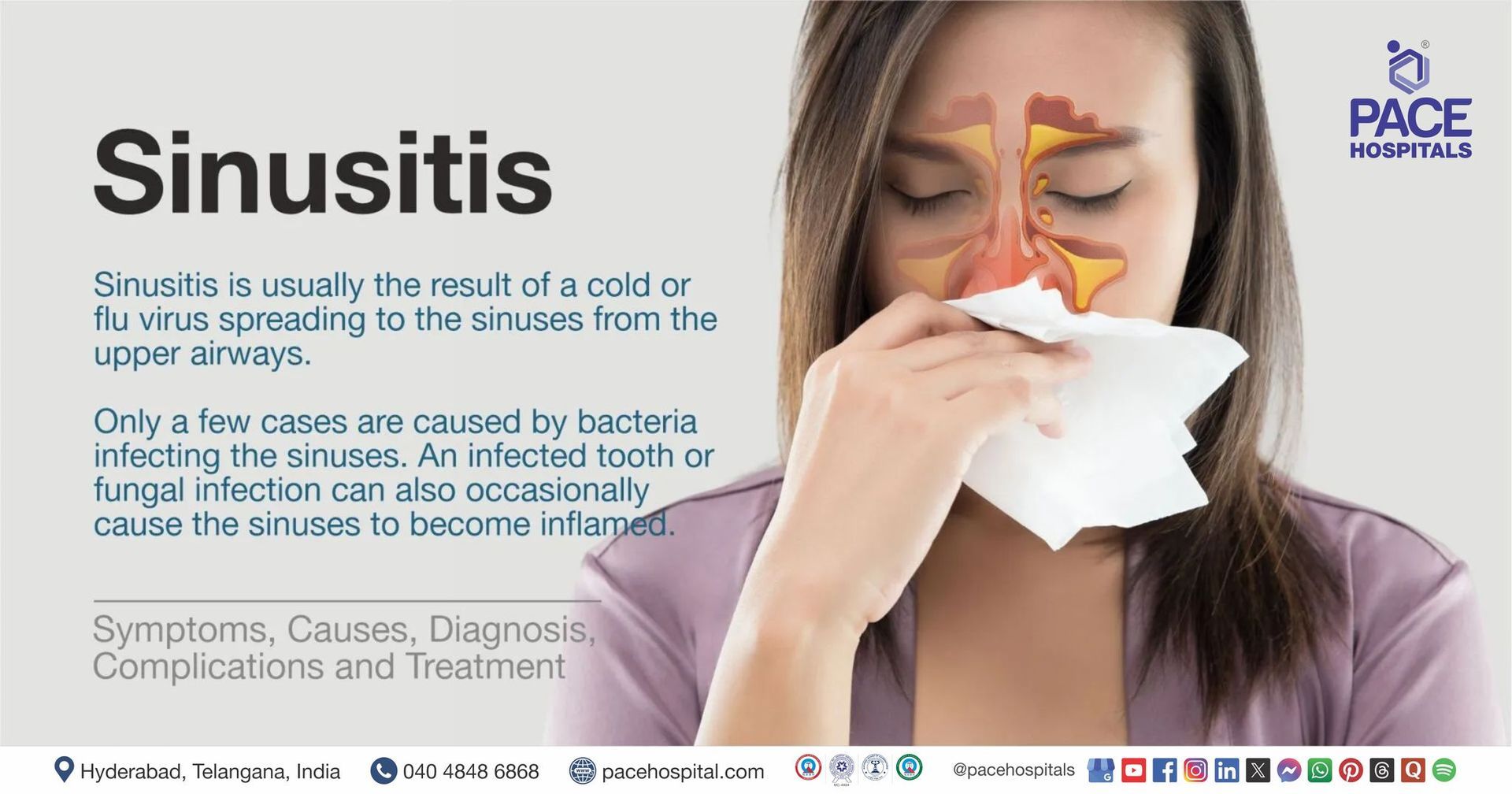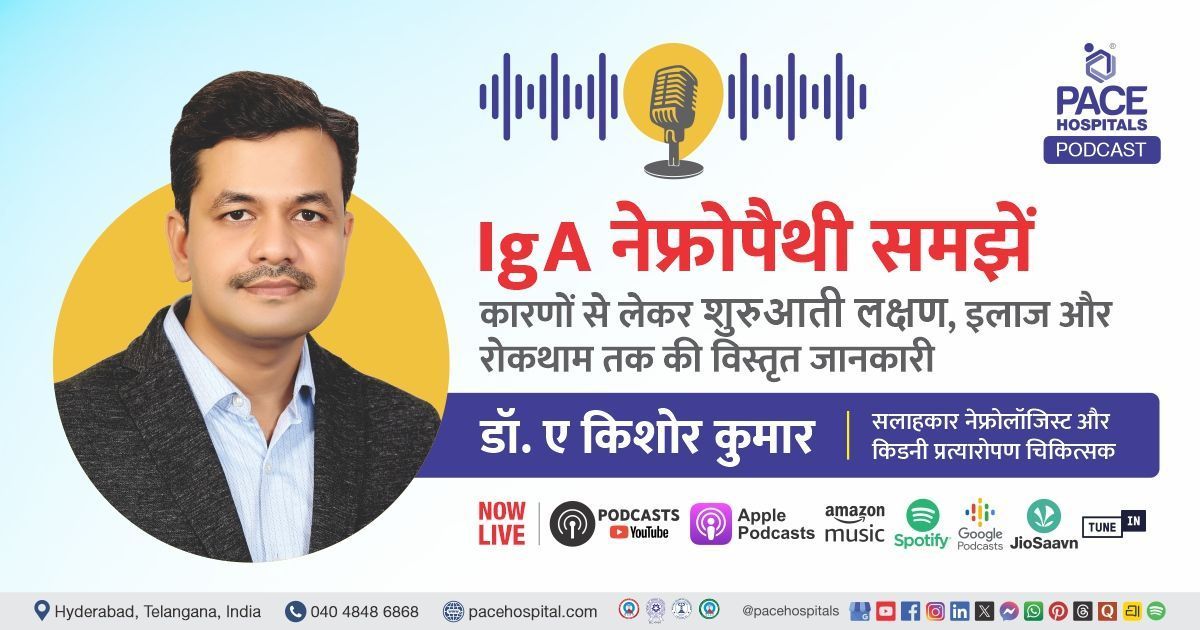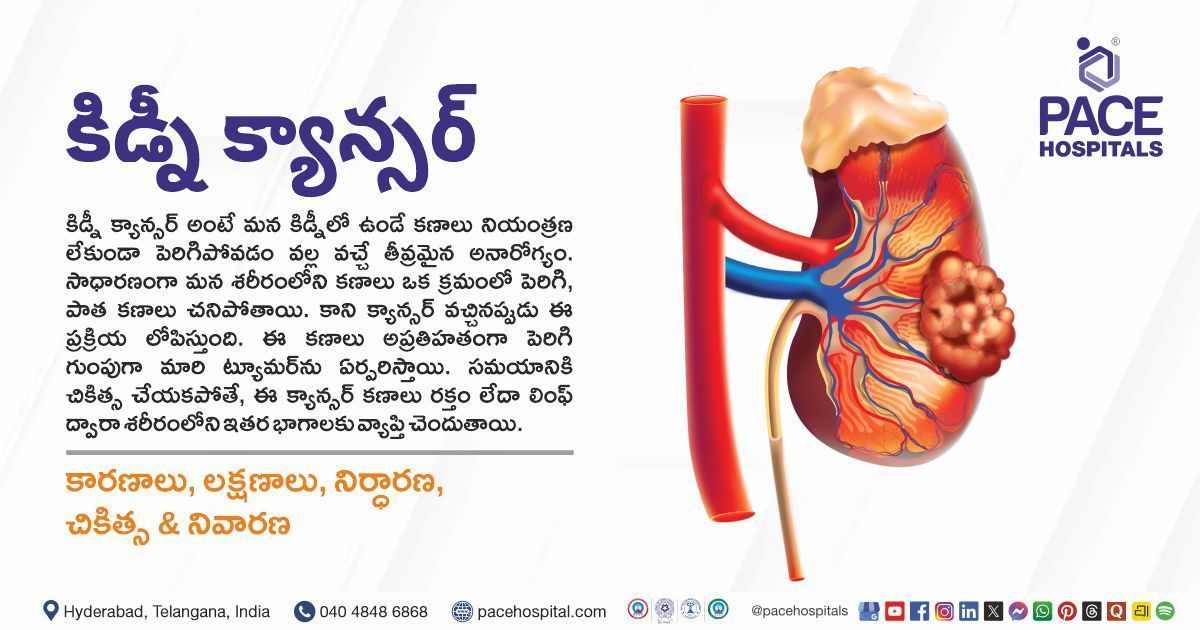Sinusitis - Types, Causes, Symptoms, Complications and Treatment
PACE Hospitals
Sinusitis is a common condition in which the lining of the sinuses becomes inflamed. It's usually caused by a viral infection and often improves within two or three weeks. The sinuses are small, air-filled cavities behind your cheekbones and forehead.
The mucus produced by your sinuses usually drains into your nose through small channels. In sinusitis, these channels become blocked because the sinus linings are inflamed (swollen). Healthy sinuses are filled with air. But when they become blocked and filled with fluid, germs can grow and cause an infection.
So, what is sinusitis? What are its signs and symptoms? And how can we manage it? Before we address the questions about sinusitis. Let’s try to understand the anatomy of sinuses and their normal functioning.
Sinus anatomy
The paranasal sinuses are air-filled extensions within our facial skeleton i.e. skull. There are four paired sinuses – named according to the bone in which they are located.
- Maxillary sinus- Either side of nose with in our cheek bones
- Ethmoidal sinus -Either side of our nose in between the eyes
- Frontal sinuses -within our forehead bone
- Sphenoid sinus- Situated far behind the nose.
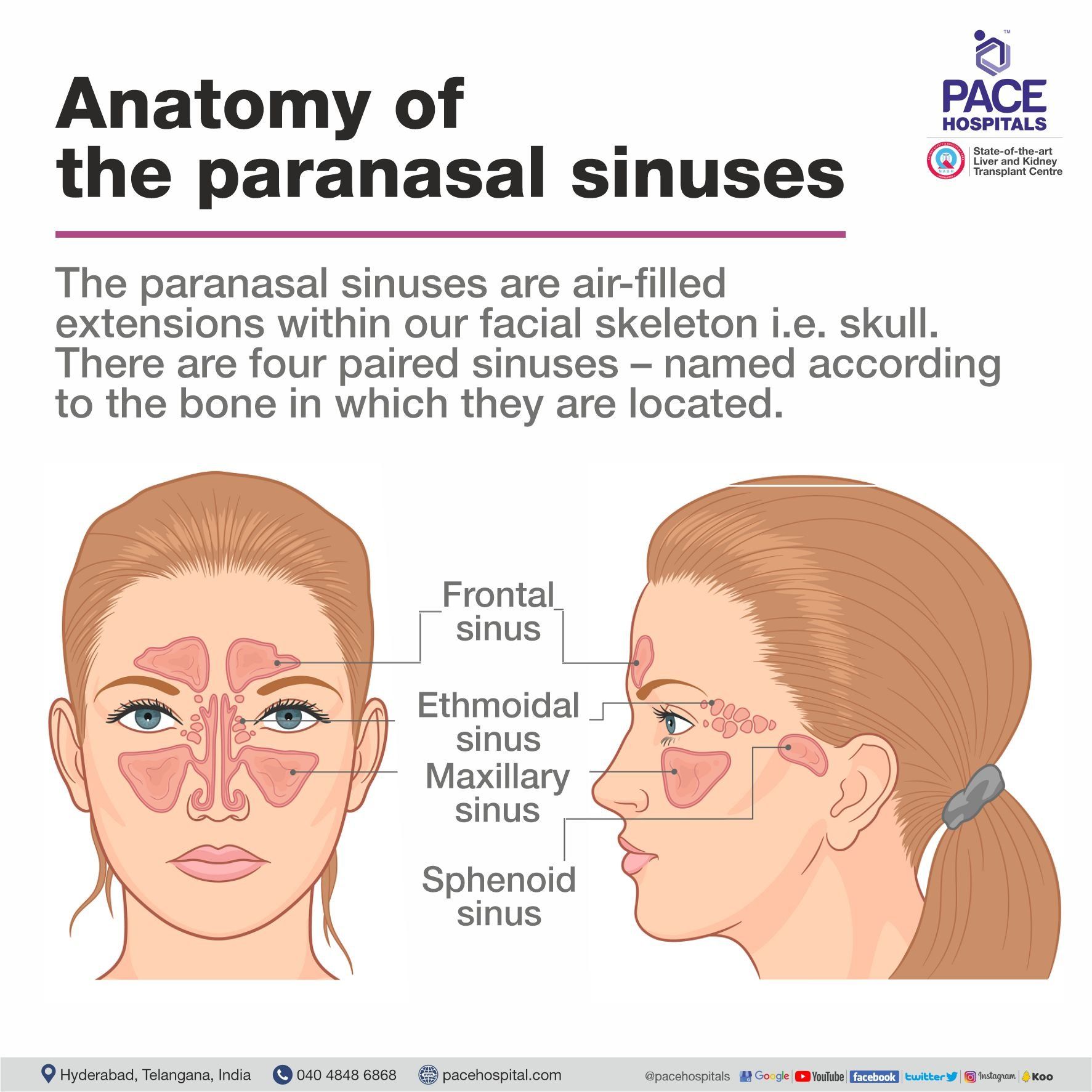
The function of the paranasal sinuses is a topic of much debate. Various roles have been suggested:
- Decreasing the relative weight of the skull
- Increasing the resonance of the voice
- Providing a buffer against facial trauma
- Insulating sensitive structures from rapid temperature fluctuations in the nose
- Humidifying and heating inspired air
- Immunological defense
Apart from above-mentioned, few other functions they serve, the main function of paranasal sinuses they essentially filter and humidify the air that we breathe before air reaches our lungs.
What is sinusitis?
Sinusitis is an inflammation of the one or more sinuses that can cause them to get blocked and filled with fluid. A sinus infection (infectious sinusitis) occurs when a virus, bacterium, or fungus grows within a sinus.
So Paranasal sinuses are supposed to be patent always to serve their function of filtering and humidification of air we breathe in. And whatever secretions that are secreted from them thereby drained out through a specified drainage pathway so that they are eliminated from the sinus system.
When this system of draining the sinuses is affected, the collections of whatever that are secreted within the sinuses they get painted up, and they get filled up within the sinuses causing inflammation of the mucous aligning the sinuses and causing infection.
What are the Signs and symptoms?
Sinusitis usually occurs after an upper respiratory tract infection, such as a cold. If you have a persistent cold and develop the symptoms below, you may have sinusitis. Common signs and symptoms of sinusitis include:
- Cloudy discoloured nasal or postnasal drip (mucus drips down the throat)
- Nasal discharge (thick yellow or green discharge from nose)
- Facial pressure (particularly around the cheeks, nose, eyes, and forehead), and or pain in your teeth or ears
- Halitosis (bad breath)
- Reduced sense of smell
- Cough, a high temperature (fever) of 100.4 F or more
- A blocked nose
- Tiredness
- Decreased sense of Smell
- Facial tenderness, occasionally facial swelling
- Feeling of nasal stuffiness
- Sore throat
- Sinus headache
- Toothache
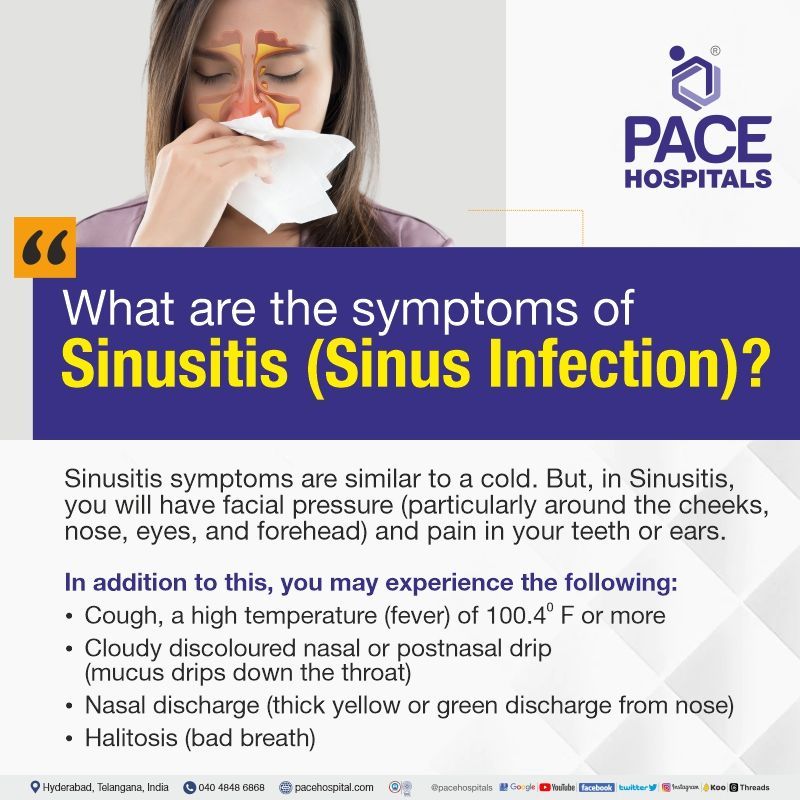
What are the types?
There are four main types of sinusitis:
- Acute sinusitis
- Subacute sinusitis
- Recurrent acute sinusitis
- Chronic sinusitis
- Acute sinusitis: This is the most common type of sinusitis. It occurs when the sinuses become inflamed and infected for less than four weeks. Most cases begin as a common cold. Symptoms often go away within a week to 10 days; but in some people, a bacterial infection develops. Acute sinusitis is usually caused by a virus, such as the common cold virus, but it can also be caused by bacteria.
- Subacute sinusitis: This type of sinusitis lasts for four to 12 weeks. It is usually caused by bacteria, but it can also be caused by a virus or fungus.
- Chronic sinusitis: Chronic sinusitis, also referred to as chronic rhinosinusitis, is often diagnosed when symptoms have gone on for more than 12 weeks, despite medical treatment. It is usually caused by bacteria, but it can also be caused by an infection, a fungus, deviated nasal septum, nasal polyps or in rare cases an immune system deficiency. People with allergic rhinitis or asthma are more likely to suffer from chronic sinusitis. This is because the airways are more likely to become inflamed when allergic rhinitis or asthma are present.
- Recurrent acute sinusitis: This type of sinusitis occurs when a person has four or more episodes of acute sinusitis in one year.
Other types of sinusitis:
- Pansinusitis: This type of sinusitis affects all four pairs of sinuses.
- Odontogenic sinusitis: This type of sinusitis is caused by an infection in the teeth or gums.
- Allergic fungal sinusitis: This type of sinusitis is caused by an allergic reaction to a fungus.
- Sphenoid sinusitis: This type of sinusitis affects the sphenoid sinuses, which are located deep behind the nose.
What causes sinusitis?
Sinusitis is usually the result of a cold or flu virus spreading to the sinuses from the upper airways. Only a few cases are caused by bacteria infecting the sinuses. An infected tooth or fungal infection can also occasionally cause the sinuses to become inflamed.
It's not clear exactly what causes sinusitis to become chronic (long-lasting), but it has been associated with:
- Mechanical obstruction – Deviated septum, any swellings within the nose like nasal polyps
- Focal infection- common cold, nasal infections, Adenotonsillitis, dental extraction, Trauma, exposure to dusty or polluted areas
- Allergies and related conditions, including allergic rhinitis, asthma and hay fever
- Immunodeficiency / a weakened immune system
- Autonomic imbalance – emotional disturbances, stress, Thermal changes, Change in humidity
- Hormones- pregnancy, puberty, hypothyroidism
- Smoking
For infants and young children, spending time in day cares, using pacifiers or drinking bottles while lying down could increase the chances of getting sinusitis, and for adults, smoking increases the risks for sinus infections.
What are the Risk factors?
Risk of getting chronic sinusitis if you have:
- A deviated septum
- Nasal polyps
- Asthma
- Aspirin sensitivity
- A dental infection
- An immune system disorder such as HIV/AIDS or cystic fibrosis
- Hay fever or another allergic condition
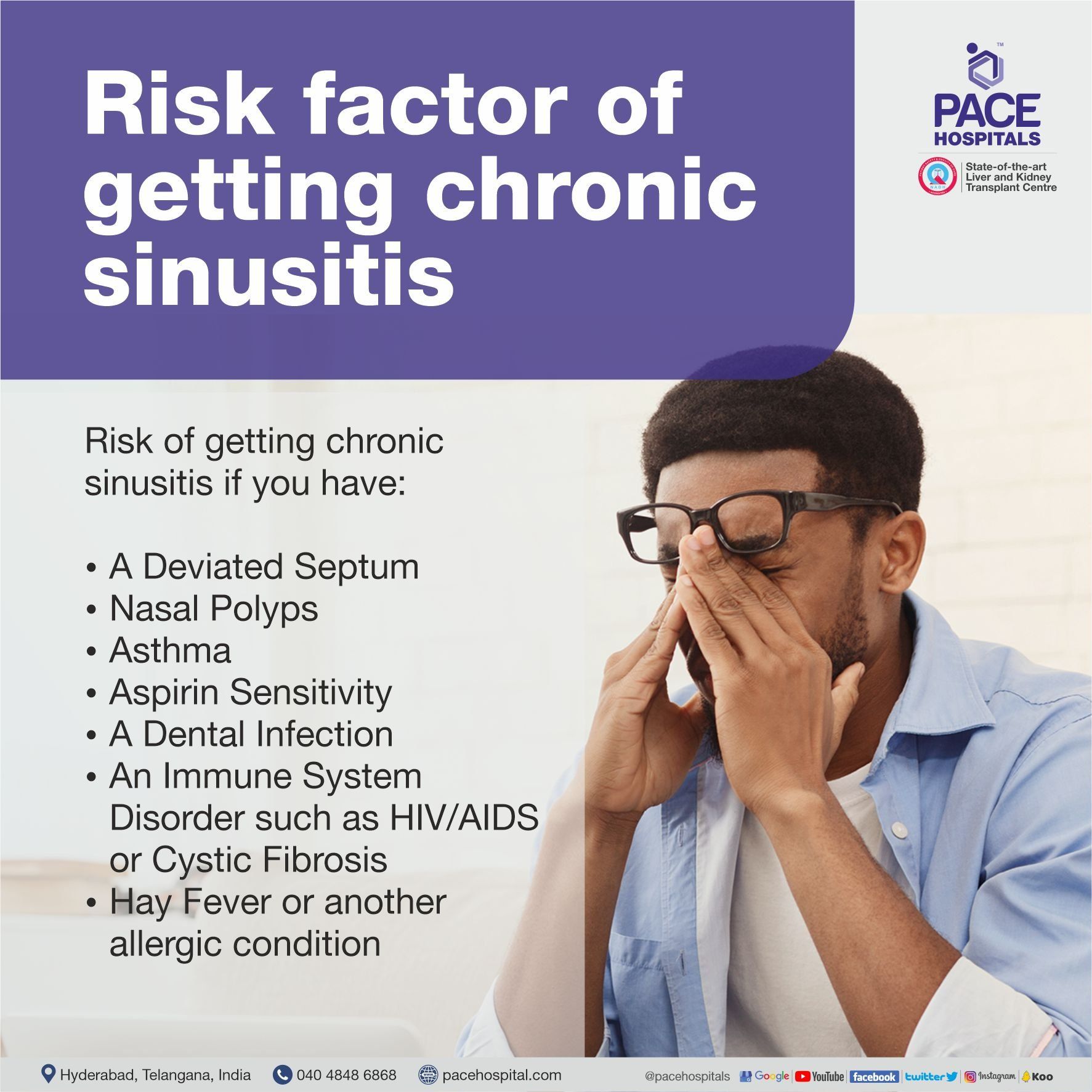
What are the Complications?
- The local complications included facial cellulitis, facial abscesses, osteomyelitis, and mucocele/mucopyocele .
- The orbital complications were classified into five groups: inflammatory oedema, orbital cellulitis, subperiosteal abscesses, orbital abscesses, and cavernous sinus thrombosis.
- The intracranial complications (IC) were classified into meningitis, brain abscesses (e.g., epidural and subdural), intracerebral abscesses, and Dural sinus thrombosis (e.g., cavernous sinus and superior sagittal sinus)
Serious complications of chronic sinusitis complications are rare, but may include:
- Vision problems. If your sinus infection spreads to your eye socket, it can cause reduced vision or possibly blindness that can be permanent.
- Infections. Uncommonly, people with chronic sinusitis may develop inflammation of the membranes and fluid surrounding the brain and spinal cord (meningitis), an infection in the bones, or a serious skin infection.
Diagnosis of Sinusitis
- Routine blood tests. These help in detection of an infection. This infection may lead to increase in the white blood cell counts. Allergies or hay fever giving rise to sinusitis may cause a rise in a specific type of white blood cells called the Eosinophil.
- The ENT specialist uses a special light to examine the inside of the nose. This helps in detection of nasal polyps, nasal bony spurs, deviated nasal septum and other anatomical defects that may lead to narrowing of nasal passages and predispose to sinusitis.
- A light is shined against the sinuses. Normally the sinus appears hollow and the light shines through, giving a reddish glow. When inflamed and blocked with secretions and mucus, the light fails to shine through, and the sinus appears opaque. This test is called the transillumination test.
- A X-ray of all the sinuses. Normal sinuses show up as hollow black cavities on either side of the forehead, bridge of the nose, behind the yes and under the cheek bones. When inflamed, the sinuses appear to be blocked with white discharge, and this is visible on X-rays.
- A new method of inspecting the insides of the sinuses is the fibreoptic endoscope or the rhino scope. This is a thin flexible tube with a camera and a light at its tip. The nasal passages are lubricated with local anaesthetics and the scope is passed. The inside walls and linings of the sinuses may be visualized with this instrument.
- When fungal sinusitis or sinus tumours are suspected or need to be ruled out imaging studies like ultrasonography of the sinuses, CT scan or MRI scan of the sinuses may be prescribed. These also help detect anatomical abnormalities of the nose and sinuses.
- Those with allergies may be recommended allergy testing to detect the cause of allergies.
- Since persons with HIV AIDS, diabetes and other poor immunity situations are more likely to get sinusitis, blood tests for these may be recommended.
- Certain tests are available to detect if the ciliary cells of the nose and sinuses are functioning adequately. Sweat Chloride tests are ordered to exclude Cystic fibrosis that predisposes to sinusitis.
- Cells of the nasal and sinus lining are taken as samples and examined under the microscope for abnormalities.
- Conditions to be ruled out in diagnosing sinusitis (because they mimic symptoms of sinusitis) include allergic rhinitis, common cold, adenoiditis in children and other causes of headaches.
Can I Prevent Sinusitis?
- Don’t smoke, and avoid other people's smoke.
- Wash your hands often, especially during cold and flu season, and try not to touch your face.
- Stay away from things you know you’re allergic to.
- Avoid upper respiratory infections. Minimize contact with people who have colds. Wash your hands frequently with soap and water, especially before meals.
- Manage your allergies. Work with your doctor to keep symptoms under control. Avoid exposure to things you're allergic to whenever possible.
- Avoid cigarette smoke and polluted air. Tobacco smoke and air contaminants can irritate and inflame your lungs and nasal passages.
- Use a humidifier. If the air in your home is dry, such as it is if you have forced hot air heat, adding moisture to the air may help prevent sinusitis. Be sure to keep the humidifier clean and free of mold with regular, thorough cleaning.
Schedule an appointment with your doctor if:
- You've had sinusitis a number of times, and the condition doesn't respond to treatment
- You have sinusitis symptoms that last more than 10 days
- Your symptoms don't improve after you see your doctor
See a doctor immediately if you have the following signs or symptoms, which could indicate a serious infection:
- Fever
- Swelling or redness around your eyes
- Severe headache
- Forehead swelling
- Confusion
- Double vision or other vision changes
- Stiff neck
Share on
Request an appointment
Fill in the appointment form or call us instantly to book a confirmed appointment with our super specialist at 04048486868

